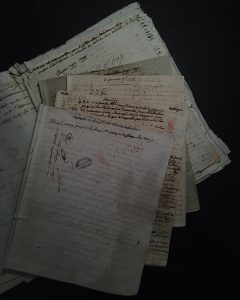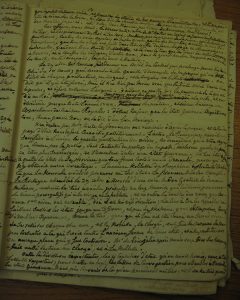In early 1794, a Revolutionary official in Paris recorded the following description of a manuscript that had come his way:
26 manuscript notebooks all written entirely in the hand of the woman Rougé-Elbeuf in which she wrote almost daily about all public and important events that occurred. She often combined in them her own reflections and gave the work the form of letters written to one of her friends. The exchange of letters … runs without interruption from late 1738 to early 1794. It is especially the last notebooks that seemed to us the most interesting. … The woman does not hide her counter-revolutionary feelings and gives an idea of the efforts the enemies of liberty undertake against us. (AN T 1625)
The duchess of Elbeuf’s papers, including the full letter-series of 26 notebooks noted by this official, were seized by the authorities in 1794 following her death. Six notebooks covering the period from 1788 were singled out as of special interest: These are the source at the heart of this project — we believe the other 20 notebooks are irretrievably lost. The six were conveyed to the Committee of General Security (effectively the police ministry of the Terror) to be analysed for intelligence about Counter-Revolutionary networks. They were said to contain ‘many uncivic remarks about our happy Revolution … she narrates the efforts that the enemies of our freedom are making against us’ (AN T 1688).
That description quoted above inspired our own project label for this set of manuscripts: ‘the Duchesse d’Elbeuf’s Letters to a Friend, 1789-1794’. But are they actually letters at all? The material mostly adopts the form of letters, but the final notebook is constructed like a diary. One of the challenges in this project is therefore to seek better to understand the ways in which the duchess used different writing genres in her account of revolutionary events and of her own life. Until we reach a conclusion we will use ‘Letters’ as a convenient way of referring to the material collectively – while also providing a link to that initial response by a revolutionary official back in 1794.
The Letters form a chronicle of informed reportage on the events of the Revolution, starting with comments on the Second Assembly of Notables in December 1788 and proceeding down to her death in early 1794. The duchess retired to her estate at Moreuil in Picardy for much of the year 1790, and then went on to Tournai in present-day Belgium for several months in 1791-2, before returning to Paris. There is a very strong Parisian focus to the Letters, although some were written from her country estate, and others during her brief period outside France. The revolutionary wars and the European scene also form part of her vision. The main foci of her comments are the deeds of the Revolutionary assemblies (notably laws passed by them and political conflicts within them), the religious schism, and the people of Paris (from heads on pikes in the street and sundry guillotinings through to the state of the weather and the price of bread).
For more information on the duchess of Elbeuf, go to The Duchess page.


